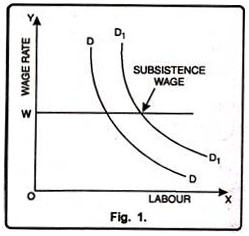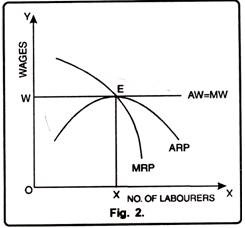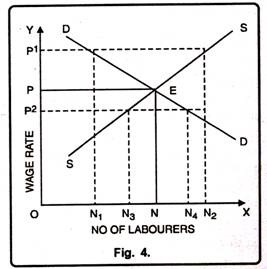The important theories of wages are as under:
A. Subsistence Theory of Wages.
B. Marginal Productivity Theory of Wages.
C. Modern Theory of Wages.
A. Subsistence Theory of Wages:
The subsistence theory of wages was first formulated by Physiocratic School of French economists of 18th century. Further, this theory was developed and improved upon by the German economists. Lasalle styled it as the Iron Law of Wages or the Brazen Law of Wages. Ricardo and Malthus also contributed to the theory of wages. Karl Marx made it the basis of his theory of exploitation.
Assumptions:
ADVERTISEMENTS:
According to Ricardo, this theory is based on the following two assumptions:
1. Population increases at a faster rate.
2. Food production is subject to the law of diminishing returns.
ADVERTISEMENTS:
According to this theory, wages of a worker in the long run are determined at that level of wages which is just sufficient to meet the necessaries of life. This level is called the subsistence level. The classical economists called it the neutral level of wages. In this way, the pro-pounders of the theory believed in the bargaining power of the workers. In such a situation, trade unions play an important role in increasing wages.
Wages of labour are equal to subsistence level in the long ran. If wages fall below this level, workers would starve. It will reduce their supply. Thus, the wage rate will rise to the subsistence level. On the other hand, if wages tend to rise above the subsistence level, workers would be encouraged to bear more children which will increase the supply of workers, which in turn will bring wages down to the subsistence level. It can be shown with the help of the following figure:
In Fig. 1 demand and supply of labour has been measured on OX-axis and wage rate on OY-axis. OW is the subsistence level of wages. At OW wage rate supply of labour is perfectly elastic. Since, supply of labour is perfectly elastic, wage rate neither can fall below OW nor can increase above the level of OW. Although demand increases from DD to D1D1 yet the wage rate remains the same at OW.
Criticism:
ADVERTISEMENTS:
Following are the main defects of the subsistence theory of wages:
1. One Sided Theory:
This theory examines the wage determination from the side of supply and ignores the demand side.
2. Pessimistic:
Subsistence theory of wages is highly pessimistic for the working class. It presents a dark picture of the future of the society.
3. Long Period:
This theory is based on the assumption of long run. It does not explain the determination of wages at a particular period of time.
4. No Historical Evidence:
This theory has been criticized on the grounds that it has not been correct in conclusions. The case of western countries is different from the conclusions of this theory.
ADVERTISEMENTS:
5. No Difference in Wages:
This theory explains that all the workers get equal wages. As we know, the workers differ in their productivity, and hence, the difference in their wages is natural.
B. Marginal Productivity Theory of Wages:
Marginal productivity theory of wages is an important theory of wages. This theory was first of all propounded by Thunnen. Later on, economists like Wicksteed, Walras, J.B Clark etc. modified the theory. The marginal productivity theory states that labour is paid according to his contribution in production. A producer hires the services of labour because he possesses the ability to contribute in production. If worker contributes more to production he is paid more wages and if he contributes less, w ages also will be low.
“Marginal productivity of labour refers to change in total revenue by putting one more labourer, keeping all the other factors constant.” Dooley
ADVERTISEMENTS:
“As a result of competition between employees for labour and between workers for employment, a wage-rate is determined that is equal to the marginal productivity of the labour-force, the employers as a whole are willing to employ.” Prof. S.E. Thomas
“The marginal productivity theory contends that in equilibrium each labourer will be rewarded in accordance with its marginal productivity”.
Assumptions:
The marginal productivity theory of wages is based on certain assumptions as stated below:
1. All labourers are equally efficient.
ADVERTISEMENTS:
2. Constant technology
3. Perfect competition prevails both in factor and product markets.
4. There is full employment in the economy.
5. Law of diminishing marginal returns apply on the marginal productivity of labour.
6. Labour is perfectly mobile.
Explanation of the Theory:
Under the conditions of perfect competition, wages are determined by the value of marginal product of labour. Marginal product of labour in any industry refers to the amount by which output increases when one more labour is employed.
ADVERTISEMENTS:
Value of marginal product of labour is the price which the marginal product can fetch in the market. Under the conditions of perfect competition, an employer will go on employing more labourers but, due to the operation of the law of diminishing returns, the marginal product of labour will diminish until a point comes when the value of the increase in the product will be equal to the wages paid to that labourer.
The marginal productivity theory can be explained with the help of the following figure:
In Fig. 2 number of labourers is measured on OX-axis and wage rate on OY-axis. ARP and MRP are average revenue productivity and marginal revenue productivity curves respectively. The equilibrium wage rate will be determined at a point where both the ARP and MRP are equal to each other.
In the figure, the equilibrium wage rate (OW) is determined at point E because at this point both the ARP and MRP are equal. The firm at OW wage rate will employ OX number of labourers. If the firm employs more workers than OX, it will have to face more losses or fewer profits. Therefore, the ideal situation for a firm is to employ workers up to the point where ARP and MRP are equal.
Why Marginal Productivity Theory is Most Satisfactory:
Here we may compare the Marginal Productivity Theory with the earlier classical theories.
ADVERTISEMENTS:
The Marginal Productivity theory is an improvement over the earlier theories in the following ways:
(i) This theory is not as rigid as the subsistence level theory and other classical theories.
(ii) It takes into consideration the demand for labour by the employers and the supply of labour, although in an indirect form.
(iii) It shows why there are differences in wage rate. Wages according to this theory vary because of marginal productivity differences of different workers.
(iv) It gives importance to the productivity of labour.
Criticism:
The marginal productivity theory of wages also suffers from certain defects as:
ADVERTISEMENTS:
1. Unrealistic Assumptions:
The foremost defect of the theory is that it is based on unrealistic assumptions like perfect competition, homogeneous character of labour etc. All these assumptions do not prevail in the real world.
2. Incomplete:
Again, this theory fails to take into account that labour is also a function of wages. Less productivity may be the effect of low wages which adversely affects the efficiency of labour and in turn reduces the labour productivity. Thus, the theory is incomplete in all respects.
3. Static Theory:
Lord J.M Keynes criticized the theory as it is based on static conditions. It is only true when there occurs no changes in the economy. But in real practice it cannot be so. Change is the law of nature, though it may come gradually.
ADVERTISEMENTS:
4. One Sided:
The marginal productivity theory is one sided. It takes into consideration only the demand side and ignores the supply side.
5. Fails to determine Wages:
This theory only guides the employer to employ workers up to the level where their marginal productivity equals price. But, it does not tell how the wages are determined.
6. Long Period:
The theory concerns itself with the long run. It explains that wages will be equal to MRP and ARP in the long run but, the long run like tomorrow never comes. In other words, it does not deal with the short-run.
C. Modern Theory of Wages:
Modern theory of wages regards wages as a price of labour and all other prices determined by the usual supply and demand analysis. According to this approach, wages are determined by the interaction of market forces of demand and supply.
Demand for Labour:
The demand for labour comes from the entrepreneurs as it is used for the production of goods and services. Thus, the demand for labour depends upon the productivity of labour i.e., the higher the productivity of labour, the greater will be the demand for it from employers. Thus, demand for labour depends upon the marginal productivity of labour; since the marginal productivity of labour will slope downwards after a stage, the demand curve of labour will also slope downward.
Factors Affecting the Demand for Labour:
1. Technological Changes:
Technological changes influence the marginal productivity of labour. Therefore, these changes also influence the demand for labour.
2. Derived Demand:
Demand for labour is a derived demand. It means that demand for labour depends upon the demand for goods and services which it produces. If at any given time the demand for a particular commodity produced by the labour is high, it is natural that the demand for labour shall also be high. Hence, the greater is the consumer demand for the product, the higher will be the demand for the labour to produce that commodity.
3. Proportion of Labour:
The demand for labour also depends upon the proportion in which labour is mixed with other factors of production. When a small amount of labour is engaged in the production of a product, the demand for that type of labour is inelastic. For instance, the demand for labour for operating automatic machines or latest machines in large scale factories is inelastic.
4. Cost of other Factors:
The demand for labour depends upon the cost of other factors of production which can be used as substitute for labour. If substitute factors are costly, the entrepreneur will naturally substitute labour in place of costly factor.
In such a case the demand for labour will be high. If the prices of substitute factors which can be used in place of labour have declined, the substitute factor will be used in place of labour. Hence, the demand for labour will decline.
This can be shown with the help of Fig. 3:
In Fig. 3 number of labourers has been measured on OX-axis and the wage rate on Y-axis. DD is the industry’s demand curve. It slopes downward from left to right indicating that when wages are low, demand for labourers increases and when the wage rate tends to increase, demand for labour decreases.
Supply of Labour:
Supply of labour in an economy depends upon both economic as well as non-economic factors. Economic factors influencing the supply of labour comprises of existing employment, desire to increase monetary income, bargaining power of the labourers, size of population, income distribution etc. while the non-economic factors consist of family affection, social conditions, domestic environment etc.
Psychological factors also affect the supply of labour. It is only due to the psychological factors that a worker decides how much time he should devote to work and how much to leisure. Moreover, the supply of labour also depends on the elasticity.
The supply of labour for a firm is perfectly elastic, so, the firm at current wages can employ as many workers as it wishes. On the contrary the nature of supply of labour for an industry is not infinitely elastic. Thus, it cannot employ more and more labourers at the current wage rate. The industry can do so by attracting labourers from other industries by offering them higher wages. Following diagram clears this point more vividly.
In Fig. 4 hours supplied has been taken on X-axis and wages on Y-axis. SS is the backward bending supply curve. OW relates to the initial wage rate. When the wage rate is OW’, the hours supplied are OX1. The maximum working hours are OX at wage rate OW. Now suppose the wage rate increases to OW”, in that case hours supplied will decrease to OX1. Thus, we may conclude that like other factors of production, supply curve of labour is also upward sloping from left to right.
Factors Affecting Supply:
1. Size of Population:
The supply of labour depends upon several factors. In the first place, the supply at any given time depends upon the number of labourers in the country. This, in itself is a result of the size of population and that proportion of this population which is called working population.
The size of population is determined by the difference in birth rate and the death rate. The proportion of total population which is called working population depends upon occupational distribution, level of technical advancement, conservation and mobility of labour.
2. Efficiency of Labour:
The supply of labour does not merely depend upon the size of population. It also depends upon the efficiency of labour. Efficiency depends upon several factors like hours of working, service and working conditions, wage rates, economic incentives and other conditions that have a bearing upon the working ability of labour.
3. Mobility of Labour:
The supply of labour also depends upon the mobility of labour. If the labour is less mobile either because the means of transport are not developed or there is conservatism among the labourers, or because there are climatic, language or traditional hindrances, then it follows that supply of labour shall be highly limited.



